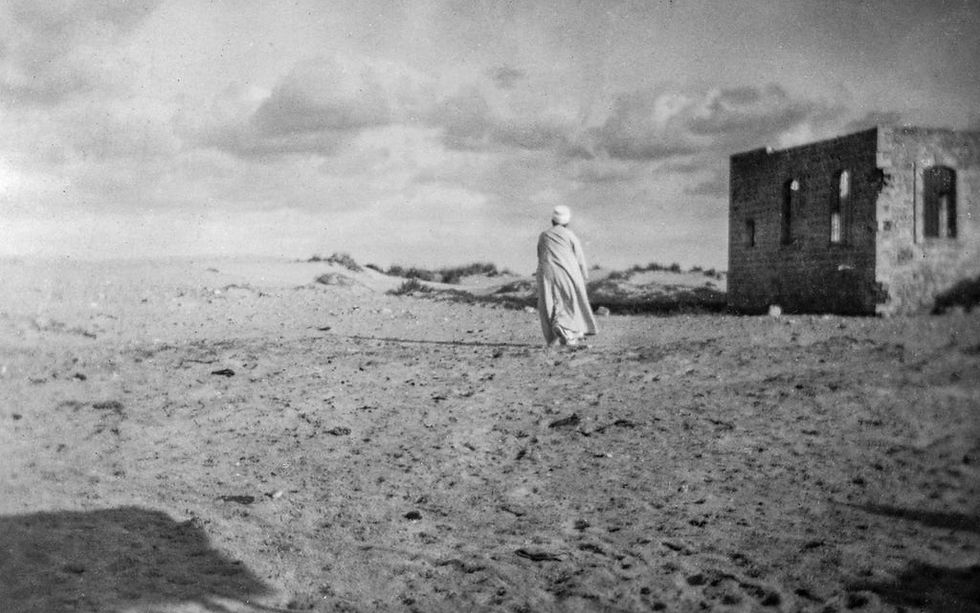Begin with the village
- Uplifting Words

- Jun 10, 2019
- 11 min read
Updated: Jun 21, 2019
The Bahá’í teachings offer a theoretical approach to rural development, but this approach is not a formula. It is meant to be tested in the real world and adapted according to local conditions.
From the early days of the Bahá’í revelation, Bahá’í communities in rural areas have striven to uplift themselves materially and spiritually through a wide range of initiatives in different contexts and fields. It must be emphasized, however, that Bahá’í communities around the world are still at the very early stages of learning about the question of village prosperity.
As they move forward into this area of experimentation and learning, they can look to ‘Abdu’l-Bahá’s activities in the field of rural reconstruction for an extraordinary example of the application of Bahá’í principles to rural development. It is instructive, then, to consider in some depth how He applied these development processes and to reflect on their current relevance.
Among His innumerable labors as head of an emerging world religion, including His extensive writings and communications (an estimated 30,000 tablets), international travel to spread the Faith, and administering to the daily needs of the poor of His own community, Akká, ‘Abdu’l-Bahá found time to put into practice many of the Bahá’í principles of rural development in a village about 100 kilometers from His home.
In 1901, ‘Abdu’l-Bahá purchased the lands of ‘Adasiyyah as a whole village estate, paying 400 Turkish gold lira. The village is situated southeast of the Sea of Galilee and south of the River Yarmuk at the north end of the Jordan River, very close to the current border between Israel and Jordan. The original area purchased was 920 hectares; however, ‘Abdu’l-Bahá immediately gave away 230 hectares, leaving a total of 690 hectares.
The village was developed in several phases. At first, ‘Abdu’l-Bahá made arrangements for several farmers to begin the work, but they found it very difficult due to the poor condition of the land and the heavy labor required. What is more, they were subject to raids by thieves who stole whatever meager crops they were able to produce. In 1907, recognizing these obstacles, ‘Abdu’l-Bahá contacted the Bahá’ís in Persia and asked them to send experienced farmers to settle in ‘Adasiyyah.
Over the next couple of years a group of farmers from around Yazd began to arrive and commenced farm operations. ‘Abdu’l-Bahá informed these farmers that they were coming to one of the most inhospitable places on Earth. In the Jordan Valley, the heat is stifling from June to September, with an average daily temperature around 38°C. Malaria was a significant problem. While the land had once been fertile and supported a large population, agriculture in the region had fallen into decline under Ottoman rule. A great deal of effort would be required to prepare the land, which was overgrown with scrub bush, much of it thorny. However, ‘Abdu’l-Bahá had told them that God would gradually make the climate of ‘Adasiyyah more comfortable, merely for the sake of the Bahá’í farmers from Iran!
These farmers would overcome many obstacles to implement the project planned and directed by ‘Abdu’l-Bahá. At first, hand labor with simple tools was used to prepare the land, but gradually draft animals and plows were added. They also had to build homes to provide for the basic needs of their families, and these and other buildings were initially made from mud brick.
Before the farmers started cultivation, ‘Abdu’l-Bahá instructed them to meet, consult, and then divide the land among themselves. Every farmer was to take charge of a certain area of farmland in proportion to the size of his family. The average allotment was based on units of 2.5–3 hectares, plus 3–6 hectares to grow food for their family and fodder for their livestock.
Precipitation was sufficient to support rain-fed grain production and ‘Abdu’l-Bahá recommended that the farmers begin by planting wheat and barley. Often the farmers visited Haifa or Akká to seek ‘Abdu’l-Bahá’s advice. He would make a specific recommendation for that season, assuring them of a bumper harvest and great bounty. At times, ‘Abdu’l-Bahá would form a partnership with a specific farmer for a certain crop, sharing expenses. These partnerships would often result in extremely high yields.
An important characteristic of the Jordan Valley is a year-round growing season, making double cropping feasible. Over time, the farmers were able to become quite productive and to produce surplus grain. Although some raiding continued to occur, security was improved by building bonds of friendship in the wider community, an activity ‘Abdu’l-Bahá had insisted on.
During the First World War, when drought conditions added to the disruption caused by the fighting, ‘Abdu’l-Bahá foresaw famine. He went to the farmers in ‘Adasiyyah and asked them to empty their granaries, excepting the amounts needed for their own use and for reseeding. He also asked them to purchase grain from farmers in the area. A train of 200 camels was dispatched to Haifa and Akká, where the grain was distributed among the local population, preventing starvation. This humanitarian effort resulted in ‘Abdu’l-Bahá being knighted by the British, who had gained control of Palestine during the war. He accepted the honor as the gift of a ‘just king’ but never used the title.
The farmers’ initial success opened new horizons. ‘Abdu’l-Bahá encouraged them to diversify their crops, and as early as 1910, they expanded into vegetable production for their families and for the market. In the beginning most farmers grew eggplant, which is easy to grow, requires little cultivation, has few pests, and produces an abundant crop. It is said the Bahá’í farmers were the first to introduce eggplant to the northwest of Jordan, Palestine, and the Golan Heights. Soon, wheat, barley, chickpeas, lentils, and broad beans were produced side by side with a wide variety of vegetables.
Next, ‘Abdu’l-Bahá encouraged the farmers to add fruit trees. He specifically instructed them to grow table grapes, oranges, lemons, tangerines, grapefruits, and limes. Fruit crops were more productive and fetched much higher prices than other farm products, especially the large yellow lemons and sesame seeds. It was customary to plant broad beans between and around pomegranate trees. Some were used fresh or dried for human consumption, but a large part of the crop was plowed into the soil while still green to improve soil texture and fertility.
‘Abdu’l-Bahá also introduced bananas to the region. During the last years of His life He received seven suckers from India. Without having ever grown bananas, He guided the farmers in ‘Adasiyyah in planting and caring for the new crop. He instructed the farmers to use the basin system of planting instead of the row system commonly used in other countries. The soil around a number of closely spaced trees was ridged up to form a small rectangular basin. The main advantage of the basin was that it held irrigation water for a longer time and allowed a gradual and slow infiltration of water into the soil.
Until that time no one in the region knew anything about this crop, let alone how to grow it. At first, the villagers were even unsure how to eat it, finding it quite unpalatable and hard to swallow—until they were shown that the outer skin must be removed. Within a few years many farmers in the region were growing bananas and profited greatly from this relatively lucrative business.
Gradually, ‘Abdu’l-Bahá’s prediction of improving conditions came true. In the early years, malaria was rampant. Some of the Bahá’ís developed the disease and even succumbed to it. To address the problem, ‘Abdu’l-Bahá instructed the community to plant a certain type of eucalyptus around the lagoon in the middle of ‘Adasiyyah. This variety produces quinine in its leaves and branches, which acts as a deterrent to the malaria parasite. The trees grew quickly, sucking up large quantities of the mosquito-infested water. Gradually the incidence of malaria declined and disappeared. The trees also had a cooling effect on the surrounding area. An added benefit was the lumber, which was purchased by builders for use in ceiling trusses.
Along with the diversification of crops, ‘Abdu’l-Bahá encouraged additional methods to improve the productivity and sustainability of the farms, such as crop rotation. The normal rotation practiced by the farmers in ‘Adasiyyah for rain-fed crops was a succession of wheat, lentils, barley, chickpeas, vetch, and white maize. Clover and alfalfa were also included in rotations, and as green manure plow downs. Since the farmers used an intensive system of crop production, fields were rarely left fallow.
In addition to the use of nitrogen-fixing legumes in rotation, manure was added to increase the yields of crops. ‘Abdu’l-Bahá encouraged the friends in ‘Adasiyyah to diversify into livestock, and in due course every farm household reared cattle, sheep, goats, poultry, and pigeons, which, in addition to meat, milk, and eggs, produced the required amounts of manure. Pastoralists who lived in the vicinity also sold manure to the farmers of ‘Adasiyyah.
The Bahá’í farmers were almost self-sufficient, in terms of their own food needs. However, ‘Abdu’l-Bahá advised them to increase their income by selling products in markets beyond the immediate boundaries of Jordan. When the Bahá’í farmers sold their products in Akká, Tiberias, Haifa, or Damascus, they purchased some of their needs from the markets in these towns. This approach contributed to the regional economy.
A key to increasing the diversity of crops and improving yields was irrigation. The community worked together to build a small dam across a portion of the River Yarmuk and collaborated to dig and maintain irrigation channels. Eventually, tractors and electric lighting were introduced. ‘Abdu’l-Bahá advised the villagers to engage in crafts and small industries. Many farmers were also artisans and a good number of them worked as part-time carpenters, while most of the women were engaged in needlework, dressmaking, and millinery.
Along with the gradually improving farming operations, ‘Abdu’l-Bahá encouraged spiritual and social aspects of village life. Problems such as those related to tenancy, transfer of the right of production, and share of irrigation water, as well as interpersonal conflicts, are bound to arise in any village setting. When the Bahá’í farmers sought ‘Abdu’l-Bahá’s advice regarding these matters, He would smile and suggest that they should sit down and pray together, consult on the resolution of the problem, and ensure that the unity of the community was maintained no matter what.
The conditions of peasants, sharecroppers, and small farmers in 19th-century Jordan under the rule of the Ottoman Empire were wretched. The peasantry was liable to rapacious profiteering by landlords. ‘Adasiyyah was a different story. The system of crop and animal production was based on a special type of sharecropping tenancy that was both innovative and fair. While the land was owned by ‘Abdu’l-Bahá and those who farmed were sharecroppers, all phases of production were planned and executed by the farmers, and seed, water, manure, and labor were provided by them. Initially, one third of the returns from farming were paid to ‘Abdu’l-Bahá, but after World War I, ‘Abdu’l-Bahá reduced His own share, so that 80% of net income would go to the farmers. ‘Abdu’l-Bahá recommended that the farmers pay their laborers a portion of their profit, in addition to wages. He told them that if they did not do so, one day these day farm laborers would come and take their share by force!
‘Abdu’l-Bahá emphasized the application of moral and spiritual values in day-to-day life and farm work. These values had a significant influence on the production and marketing systems of the farmers, improving their fortunes. Furthermore, He strongly recommended that they establish warm bonds of friendship with the people they met or had business dealings with and conduct all their affairs with high rectitude of conduct.
In view of His great interest in rural and agricultural development, ‘Abdu’l-Bahá would occasionally visit the village. The Bahá’í community would then hold 19-Day Feasts and other Bahá’í meetings in His presence. His first visit was in 1914 and lasted for almost a month. During his last visit, in 1920, Shoghi Effendi accompanied him, and they both inspected the area on horseback. Shoghi Effendi continued to advise the community throughout his ministry.
At its peak there were around 1,000 people in the village and surrounding area. The first Spiritual Assembly of the Bahá’ís of ‘Adasiyyah was elected in 1924 to direct the affairs of the community. All matters relating to farming and animal production, including allotments of land, were discussed and conducted by a farming committee working under the auspices of the Assembly. A spacious two-story building erected and completed in 1931 was dedicated for use as a local Bahá’í administrative center, or Haziratu’l-Quds.
In the early days, the education of the children took place at home. It was the task of the parents and older members of the family to educate the younger ones. In this respect, the mother of the family played a significant role. In the evenings, the Bahá’ís, irrespective of age, attended literacy classes. At a later stage, a school was set up for classes from grades one to nine, with a higher grade for those wishing to advance further. Teachers were selected from the community and outside, and education was provided free of charge.
It is reported that Shoghi Effendi repeatedly emphasized that since ‘Adasiyyah was in the midst of an Arabic-speaking population, it was important that children were taught Arabic so that they could easily mix with the local people and establish friendships with them. In 1934, the Spiritual Assembly hired a graduate from the Kulliyyih School in Beirut to teach Arabic and English.
Much of the curriculum was based on the Persian and Arabic writings of the central figures of the Bahá’í Faith, and most children could easily recite by heart some thirty tablets of Bahá’u’lláh and ‘Abdu’l-Bahá. Girls attended a different class from the boys. Normally the boys would be in the school in the mornings learning Persian, Arabic, and Bahá’í laws and teachings, while the girls were learning English, geography, history, mathematics, and sciences. This arrangement was reversed in the afternoons.
Shoghi Effendi used to recommend that the farmers, as well as their sons and daughters, study agriculture and learn about appropriate methods and techniques so that they could enhance the development of agriculture and spearhead rural change in their area.
During the lifetimes of both ‘Abdu’l-Bahá and Shoghi Effendi, agricultural development and implementation of rural development programs attracted the attention of many people near and far. ‘Adasiyyah soon became an agricultural showplace for the whole of Jordan. If the government wished to show how advanced it was in agricultural production and farming techniques, it would bring foreign guests and dignitaries to ‘Adasiyyah, a brilliant star in an otherwise semi-arid scrubland. Even members of the royal family visited the village.
Ultimately due to Jordanian land reforms in the 1960s, the Bahá’ís were not able to continue to live in ‘Adasiyyah and moved to other areas, or even other countries, to support the worldwide growth of the Bahá’í faith. However, the principles and practices of village life and farming initiated by ‘Abdu’l-Bahá in the village still offer a relevant example of just, productive, and sustainable rural development applicable to one third of humanity, the smallholder farmers who produce much of the world’s food. In fact, the development principles followed by ‘Abdu’l-Bahá addressed a range of social and ecological concerns that have since intensified. The redevelopment of ‘Adasiyyah accomplished three things that, if replicated, would greatly contribute to the development of rural areas and the world:
1. Ecological and climate services
With the encouragement of ‘Abdu’l-Bahá, the community of ‘Adasiyyah restored degraded, eroded, and deforested land, improved soil quality, improved water use efficiency, and increased crop diversity, including the use of perennial tree crops and forages. Today, this approach, which requires minimal external inputs, is known as agroecology, an effort to farm in a manner that mimics the functions of the natural ecosystem.
The distinguished soil scientist Rattan Lal has estimated that the technical potential of a range of measures to increase carbon sequestration in croplands, forests, and grasslands—not unlike those adopted in ‘Adasiyyah—is greater than the net annual increase in atmospheric CO2. If smallholder farmers were paid for climate and ecological services, this would be a low-cost approach to climate change mitigation. It would also increase food production and raise the living standard of farmers. The potential of this approach is large. Lal estimates that 3.5 billion hectares, close to one quarter of Earth’s land surface, are degraded and desertified lands. Applying low-input farming methods such as those used in ‘Adasiyyah to these lands could provide opportunities for rural people, especially rural youth, to restore ecosystem services, increase biodiversity, mitigate climate change, and increase the food supply.
2. Social-economic development
The initial capital investment by ‘Abdu’l-Bahá was the catalyst that allowed families in ‘Adasiyyah to prosper. They were able to transform scrubland into a productive farm that eventually supported hundreds of residents and contributed to the local and regional economy. The farm provided high-quality food for the village and urban areas. The generous sharecropping arrangement and profit sharing improved the standard of living of residents and non-resident farm laborers.
Small investments in smallholder farms and villages could eliminate extreme poverty while improving productivity, assuring a sustainable food supply for a burgeoning world population. Rattan Lal estimates that green investments of as little as $25 per smallholder farm would facilitate the adoption of sustainable methods.
3. Moral capacity
Material self-reliance brings a sense of dignity. ‘Abdu’l-Bahá went further, encouraging the residents of ‘Adasiyyah to pay equal attention to their moral development. This was achieved through education, both material and spiritual, for the children, youth, and adults, and through regular devotional meetings. Education supported a dual moral purpose: to develop the potentialities of the individual and to enhance their capacity to be of service. Building this capacity helped community members to live harmoniously. A local governing institution was elected to administer the material and spiritual needs of the community. In this way, the moral capacity of the individual, the community, and its institutions increased.





















